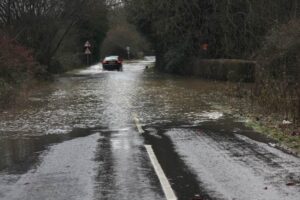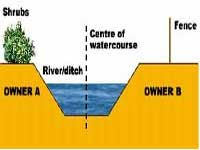As the rain finally comes to quench the earth’s thirst, how are you finding our infrastructure?
Write in and let Cranleigh Society know how it is for you please. [email protected] or simply write in the comment box below this post.
The photo shows flooding in Cranleigh in the winter of 2013. Since then hundreds of dwellings have been built and a great deal of land that mopped up and gently allowed water to drain over time has gone for dwellings. New People are welcome and we wish them very well especially regarding where the rain goes.
The waterways of Cranleigh are famous for bringing life to the village and its plants and animals. But people are only keen if it goes where they let it. Rivers and streams naturally meander, finding their own way down, creating habitats along the way, so if people have overdeveloped it’s no wonder the water interferes with our lives. Flooding of course goes away and if people are careful it causes inconvenience only. Cranleigh is at the bottom of many hills and so it’s obvious that water finds its way here sometimes surging down the roads as they are easy routes. Once it gets to housing it can be a problem and go into buildings. It can fill up drains and cause sewage to emerge in people’s homes.
Is there anything we can do?
People have a duty to help water find its way down – so if you have ditches, streams, rivers as part of land you own, you must keep it clear of rubbish and let nature take its course. Surrey County Council want us all to take care of our ditches – here is a leaflet saying how.
Do you have a watercourse, such as a ditch, stream or river running through, or alongside, your property? If so, you are probably responsible for its maintenance and in legal terms you are a ‘riparian owner’.
 Are you a riparian owner?
Are you a riparian owner?
If you have an ordinary watercourse or a main river running through your land or along the boundary of your property, you are likely to be the riparian owner or joint riparian owner; unless the watercourse is known to be owned by someone else. If the land on the other side of the watercourse is not in your ownership you are presumed to be the joint riparian owner together with the landowner on the other side. In the case of joint riparian ownership each party is presumed to own up to the centre line of the watercourse and therefore is responsible up to this point. If you are unsure whether you are the riparian owner of the watercourse running through your land, check the title deeds of your property.
Your rights
- To receive a flow of water in its natural state, without undue interference in quantity or quality;
- To protect your property against flooding from the watercourse and to prevent erosion of the watercourse banks or any nearby structures;
- You usually have the right to fish in your watercourse however you must use legal methods and may need a rod licence;
- Without an environmental permit, you can abstract a maximum of 20 cubic metres of water per day for the domestic purposes of your own household or for agricultural use (excluding spray irrigation). Most other types of abstraction will require a licence from the Environment Agency.
Your responsibilities
- You have the responsibility to pass on flow without obstruction, pollution or diversion affecting the rights of others;
- To maintain the banks and bed of the watercourse (including any trees and shrubs growing on the banks) and any flood defences that exist on it;
- To maintain any approved structures on your stretch of the watercourse. These may include culverts, trash screens, weirs and mill gates;
- You must not build a new structure (for example, a bridge or boardwalk) that encroaches upon the watercourse or alters the flow of water without first obtaining permission from Surrey County Council or the Environment Agency.
Map of asbestos pipes in Cranleigh, 01-Feb-17


 Are you a riparian owner?
Are you a riparian owner?
